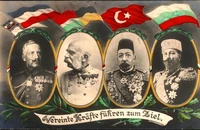| This Central World page is a Proposal.
It has not been ratified and is therefore not yet an official part of the Central World Timeline. You are welcome to correct errors and/or comment at the Talk Page of this article. If you add this label to an article, please do not forget to make mention of it on the main Discussion page for the Timeline. |
Concordia res parvae crescunt (Latin) ("Concord makes small things grow") | |||||||
| Anthem | "Verenigd in Vrijheid" | ||||||
| Capital | The Hague | ||||||
| Largest city | Brussels | ||||||
| Other cities | Amsterdam, Rotterdam, Antwerp, Utrecht, Ghent, Eindhoven, Tilburg, Almere, Groningen | ||||||
| Language official |
Dutch, West Frisian | ||||||
| others | Flemish, French, German, Low Franconian, Low Saxon | ||||||
| Religion main |
None | ||||||
| others | Roman Catholic, Protestantism, Islam, Judaism | ||||||
| Ethnic Groups main |
Dutch, Frisian | ||||||
| others | Aruban, Dutch Antillean, Dutch Indonesian, French, German, Surinamese | ||||||
| Demonym | Dutch | ||||||
| Government | Presidential republic | ||||||
| Legislature | Parliament, Senate and the National Assembly | ||||||
| President | Yves Leterme | ||||||
| Prime Minister | Emile Roemer | ||||||
| Area | 55,209 km2 | ||||||
| Population | 23,753,458 inhabitants | ||||||
| Currency | Euro | ||||||
| Time Zone | UTC +1 | ||||||
| summer | UTC +2 | ||||||
| Calling Code | +31 | ||||||
| Internet TLD | .nl | ||||||
| Organizations | European Community, Organization of Nations | ||||||
The Netherlands, officially the Republic of the Netherlands, is a country in western Europe, bordered by Germany to the east and France to the south.
History[]
Geography[]
Economy[]
Government and administration[]
Government[]
Political parties[]
Administrative divisions[]
The Republic of the Netherlands is partitioned into twelve historic provinces, which are:
- Friesland (Leeuwarden)
- Groningen (Groningen)
- Drenthe (Assen)
- Holland (Amsterdam)
- Flevoland (Lelystad)
- Overijssel (Zwolle)
- Gelderland (Arnhem)
- Zeeland (Middelburg)
- Noord-Brabant ('s-Hertogenbosch)
- Vlaanderen (Brugge)
- Zuid-Brabant (Brussel)
- Limburg (Maastricht)
During the reclamation of Flevoland from the IJsselmeer between 1940 and 1986, there were also plans in 1976 to drain the newly formed Markermeer and create the province of Markerwaard. The overambitious fascists initially approved, but as the government became preoccupied with the political and civil problems of the 1980s, the project was canceled. Successive government formations, including the current, did not have official stances on the matter, although most people dislike the idea of the IJsselmeer disappearing and the population increasing even more.
Demographics[]
Language[]
Almost all inhabitants speak Dutch (Nederlands), a Germanic language spoken in the low countries since the seventh century. It is also the official language of the republic, together with Frisian (Frysk), another Germanic language spoken in the north of the Netherlands, Germany and southern Denmark since the early eight century. However, the latter language is only co-official in the province of Friesland and on a steady rise due to compulsory language lessons on all schools in the province.
The Netherlands also houses a variety of Low Franconian and Low Saxon dialects. The linguistics department of the government recognizes the following dialects and languages:
- Brabantian - A group of dialects in Noord- and Zuid-Brabant and Limburg.
- Drents - A majority dialect in the province of Drenthe.
- East Flemish - A Dutch dialect in Vlaanderen and Zeeland.
- Frisian - The official language in the province of Friesland.
- Gronings - A group of Friso-Saxon dialects in the province of Groningen.
- Guelderish - A dialect spoken mostly in Gelderland and Overijssel.
- Hollandic - The most common dialect of the Dutch language, originating from Holland.
- Limburgish - A Franconian language in Limburg.
- South Guelderish - A group of Brabantian dialects spoken along the river Rhine.
- Twents - A majority dialect in the region of Twente in the province of Overijssel.
- Veluws - Two Low Saxon dialects on the Veluwe in Gelderland.
- West Flemish - A group of Dutch dialects spoken in Vlaanderen and Zeeland.
- West Frisian - A group of Friso-Hollandic dialects in the north of Holland.
Besides these native languages, the Dutch are also renowned for their knowledge of the most prominent foreign languages. According to surveys from the Ministry of Education, Culture and Science (MOCW) 89% of the population is able to properly converse in English, 70% in German, 40% in French and 15% in Spanish.
Religion[]
Culture[]
Education[]
Military[]
Main article: Military of the Netherlands
| |||||||||||||||||






